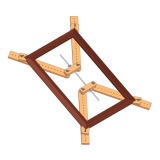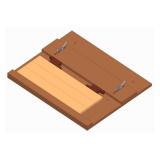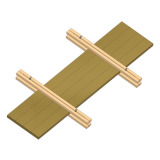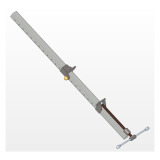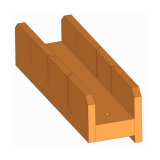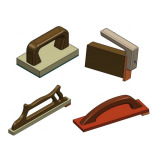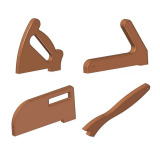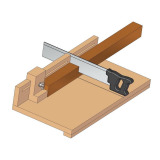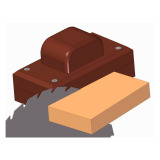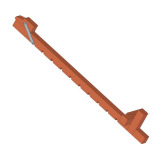In this category of our website we offer free DIY projects to help you make wooden and metal jigs, fixtures and clamps.
In order to make use of your carpentry tools and machines to the fullest, in your workshop you need some jigs and fixtures. Also, a sufficient number of clamps of various types and sizes are in demand to replace a reliable extra pair of hands during the manufacturing of parts and the assembly process. One of the most essential features of jigs and fixtures is safety, which can be assumed from their very definitions that they are supposed to hold the workpiece instead of the craftsman. This is very important as we know that cutting tools are extremely sharp and have a high rotational speed. Although commercial jigs, fixtures and clamps can be easily purchased, there is a large number of craftsmen who make them themselves, relying on their previous experience, specific needs or plans found in books or on the Internet.
Adjustable 4 corner framing clamp can be easily made out of various scraps left from the previous projects and its functionality is the same as that of the commercial framing clamps.
On this page you can find plan that you can use for making board-gluing fixture which is a great alternative to pipe clamps.
With this plan you can make a Crossbar for edge gluing, a simple but very useful clamp.
Bar clamps are an indispensable tool when you need to temporarily hold work securely in place. They are most commonly used when gluing wood or welding metal parts.
With the free woodworking project that you can download on this page you can make a miter box, which should be an integral part of every hobby workshop.
In addition to the drawings for making push sticks on this page, we also offer drawings for several push block variants.
In front of you, there are drawings that will allow you to make several variants of push sticks (notched push sticks and shoe push sticks).
On this page, we present a jig that allows you to cut slats//laths quickly and easily into same-length pieces using a hand saw.
Due to extensive use of wedges, here we are presenting a very simple jig with which you can easily and quickly cut a large number of wedges.
With the free woodworking project that you can download on this page you can make a wooden bar clamp.
Jigs
A jig's primary purpose is to:
- position the workpiece,
- hold it firmly in place,
- and to guide the workpiece in relation to the tool that you are using.
With the use of jigs, an increase in productivity, accuracy, repeatability and interchangeability is achieved. It should be noted that due to machinery automation and development of computer numerical controlled (CNC) machines the interest in jigs has declined (tool path is digitally programmed). In small workshops jigs are very much used, especially in woodworking. There is a large number of jig types, and each is designed to perform a specific job. In carpentry we usually deal with: Dowel Jig, Dovetail Jig, Router Jigs, Trammel arm jig, Miter jig, Tenoning jig, Drill press jig...
Fixtures
Fixtures are devices used:
- to position the workpiece and
- to hold it firmly in place so that a certain operation can be carried out.
A fixture will secure the workpiece, making for a cleaner, more precise cut. There is a large number of fixture types that are classified into general-purpose (Vises, chucks, miter gauges, feather boards) and special- purpose fixtures (designed for a specific workpiece, machine or process).
Clamps
A clamp is a fastening device whose role is to hold the parts firmly together, i.e. to prevent any moving of parts or sub-assemblies relative to one another. From the above definition, we conclude that clamps are most commonly used in cutting or gluing operations in carpentry, welding or cutting in metalworking and the like. There is a large number of clamps for different purposes: C-clamps, bar clamps, pipe clamps, band clamps, picture frame clamps... Clamps can be found in almost every workshop, because they are simply irreplaceable; when it comes to performing various specific tasks, their main purpose is to replace a reliable extra pair of hands needed by every handyman.
